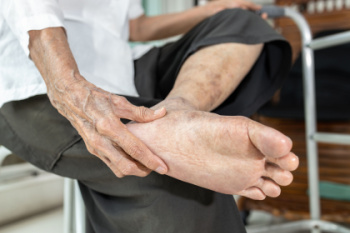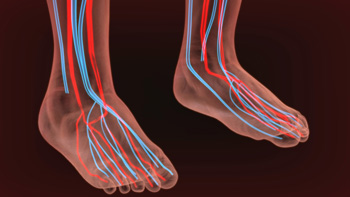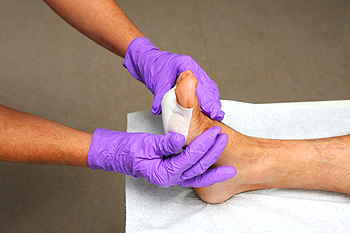Items filtered by date: August 2024
Ankle Pain Related to the Tarsal Tunnel

Tarsal tunnel syndrome is a condition that causes pain on the inside of the ankle, extending to the foot and sometimes the toes, caused by compression of the posterior tibial nerve. This nerve travels through the tarsal tunnel, a narrow space inside the ankle that also contains blood vessels and tendons. When the tissues surrounding the tarsal tunnel become inflamed, they can press on the nerve, causing burning, tingling, and pain, especially during walking or when wearing certain shoes. Factors that can contribute to this condition can include foot injuries, swelling from other medical issues, or improper foot posture. A podiatrist can diagnose tarsal tunnel syndrome through a physical examination, sometimes using nerve conduction studies or imaging tests to determine the extent of the compression. Treatment options include corticosteroid injections, custom orthotic devices, and, in some cases, surgery to relieve the pressure on the nerve. If you have pain on the inside of the ankle, it is suggested that you schedule an appointment with a podiatrist for an exam and treatment.
Ankle pain can be caused by a number of problems and may be potentially serious. If you have ankle pain, consult with one of our podiatrists from Barry University Foot and Ankle Institute. Our doctors will assess your condition and provide you with quality foot and ankle treatment.
Ankle pain is any condition that causes pain in the ankle. Due to the fact that the ankle consists of tendons, muscles, bones, and ligaments, ankle pain can come from a number of different conditions.
Causes
The most common causes of ankle pain include:
- Types of arthritis (rheumatoid, osteoarthritis, and gout)
- Ankle sprains
- Broken ankles
- Achilles tendonitis
- Achilles tendon rupture
- Stress fractures
- Bursitis
- Tarsal tunnel syndrome
- Plantar fasciitis
Symptoms
Symptoms of ankle injury vary based upon the condition. Pain may include general pain and discomfort, swelling, aching, redness, bruising, burning or stabbing sensations, and/or loss of sensation.
Diagnosis
Due to the wide variety of potential causes of ankle pain, podiatrists will utilize a number of different methods to properly diagnose ankle pain. This can include asking for personal and family medical histories and of any recent injuries. Further diagnosis may include sensation tests, a physical examination, and potentially x-rays or other imaging tests.
Treatment
Just as the range of causes varies widely, so do treatments. Some more common treatments are rest, ice packs, keeping pressure off the foot, orthotics and braces, medication for inflammation and pain, and surgery.
If you have any questions, please feel free to contact our offices located in Miami, North Miami Beach, Miami Beach, and Tamarac, FL . We offer the newest diagnostic and treatment technologies for all your foot care needs.
Causes and Symptoms of Poor Foot Circulation

Poor foot circulation, often linked to peripheral vascular disease, or PVD, can cause significant discomfort and health issues. Symptoms can include numbness, tingling, and cold feet, in addition to noticeable changes in skin color or wounds that heal slowly. Common causes of poor circulation include diabetes, smoking, and prolonged sitting or standing. To alleviate symptoms, adopting lifestyle changes is vital. Regular exercise, such as walking or cycling, helps improve blood flow. Elevating the feet and avoiding wearing tight footwear can also enhance circulation. Additionally, quitting smoking and managing underlying conditions like diabetes contribute to better vascular health. If you have any of the above symptoms, it is strongly suggested that you promptly visit a podiatrist who can accurately diagnose and treat poor circulation.
Poor circulation is a serious condition and needs immediate medical attention. If you have any concerns with poor circulation in your feet contact one of our podiatrists of Barry University Foot and Ankle Institute. Our doctors will treat your foot and ankle needs.
Poor Circulation in the Feet
Poor blood circulation in the feet and legs is can be caused by peripheral artery disease (PAD), which is the result of a buildup of plaque in the arteries.
Plaque buildup or atherosclerosis results from excess calcium and cholesterol in the bloodstream. This can restrict the amount of blood which can flow through the arteries. Poor blood circulation in the feet and legs are sometimes caused by inflammation in the blood vessels, known as vasculitis.
Causes
Lack of oxygen and oxygen from poor blood circulation restricts muscle growth and development. It can also cause:
- Muscle pain, stiffness, or weakness
- Numbness or cramping in the legs
- Skin discoloration
- Slower nail & hair growth
- Erectile dysfunction
Those who have diabetes or smoke are at greatest risk for poor circulation, as are those who are over 50. If you have poor circulation in the feet and legs it may be caused by PAD and is important to make changes to your lifestyle in order to reduce risk of getting a heart attack or stroke. Exercise and maintaining a healthy lifestyle will dramatically improve conditions.
As always, see a podiatrist as he or she will assist in finding a regimen that suits you. A podiatrist can also prescribe you any needed medication.
If you have any questions please feel free to contact our offices located in Miami, North Miami Beach, Miami Beach, and Tamarac, FL . We offer the newest diagnostic and treatment technologies for all your foot and ankle needs.
Osteoarthritis of the Ankle
 Ankle osteoarthritis is a relatively uncommon condition often arising years after an ankle injury that damages the cartilage. Unlike other forms of arthritis, it tends to affect younger individuals, especially those with a history of trauma to the joint. Excess weight can worsen the condition by increasing stress on the ankle and accelerating cartilage deterioration. Symptoms of ankle osteoarthritis include pain, stiffness, and swelling in the joint, which can increase with activity and improve with rest. Patients may also experience a reduced range of motion and a feeling of instability in the ankle. Diagnosis typically involves a physical examination, patient history, and imaging tests, such as X-rays or MRI scans, to assess cartilage damage and joint space narrowing. Treatment focuses on managing symptoms and improving joint function. Conservative approaches include weight management, targeted stretching exercises, anti-inflammatory medications, and orthotics. In severe cases, surgical options like ankle arthroscopy, fusion, or joint replacement may be considered to alleviate pain and restore mobility. If you have persistent ankle pain, it is suggested that you schedule an appointment with a podiatrist for a proper diagnosis and treatment.
Ankle osteoarthritis is a relatively uncommon condition often arising years after an ankle injury that damages the cartilage. Unlike other forms of arthritis, it tends to affect younger individuals, especially those with a history of trauma to the joint. Excess weight can worsen the condition by increasing stress on the ankle and accelerating cartilage deterioration. Symptoms of ankle osteoarthritis include pain, stiffness, and swelling in the joint, which can increase with activity and improve with rest. Patients may also experience a reduced range of motion and a feeling of instability in the ankle. Diagnosis typically involves a physical examination, patient history, and imaging tests, such as X-rays or MRI scans, to assess cartilage damage and joint space narrowing. Treatment focuses on managing symptoms and improving joint function. Conservative approaches include weight management, targeted stretching exercises, anti-inflammatory medications, and orthotics. In severe cases, surgical options like ankle arthroscopy, fusion, or joint replacement may be considered to alleviate pain and restore mobility. If you have persistent ankle pain, it is suggested that you schedule an appointment with a podiatrist for a proper diagnosis and treatment.
Arthritis can be a difficult condition to live with. If you are seeking treatment, contact one of our podiatrists from Barry University Foot and Ankle Institute. Our doctors can provide the care you need to keep you pain-free and on your feet.
Arthritic Foot Care
Arthritis is a joint disorder that involves the inflammation of different joints in your body, such as those in your feet. Arthritis is often caused by a degenerative joint disease and causes mild to severe pain in all affected areas. In addition to this, swelling and stiffness in the affected joints can also be a common symptom of arthritis.
In many cases, wearing ill-fitting shoes can worsen the effects and pain of arthritis. Wearing shoes that have a lower heel and extra room can help your feet feel more comfortable. In cases of rheumatoid arthritis, the arch in your foot may become problematic. Buying shoes with proper arch support that contour to your feet can help immensely.
Alleviating Arthritic Pain
- Exercises that stretch the foot can prevent further pain and injury and increase mobility
- Most of the pain can be alleviated with anti-inflammatory drugs, heat, and topical medications
- Massages can help temporarily alleviate pain.
It is best to see your doctor for the treatment that is right for your needs and symptoms. Conditions vary, and a podiatrist can help you determine the right method of care for your feet.
If you have any questions, please feel free to contact our offices located in Miami, North Miami Beach, Miami Beach, and Tamarac, FL . We offer the newest diagnostic tools and technology to treat your foot and ankle needs.
Recognition and Treatment of Infected Foot Wounds
 Recognizing an infected foot wound is essential for prompt treatment and prevention of serious complications. Signs of infection include increased redness, swelling, warmth around the wound, and persistent pain. The wound may also produce pus or an unpleasant odor, and systemic symptoms such as fever or chills can occur. Immediate treatment involves thoroughly cleaning the wound with mild soap and water. Applying an antiseptic solution helps reduce bacterial load. Cover the wound with a sterile bandage and change it daily or as needed to keep it clean and dry. Mild pain relievers can help manage discomfort. Individuals with diabetes or compromised immune systems should be particularly vigilant, as they are at higher risk for complications. Early intervention and proper care are key to effectively treating an infected foot wound and promoting healing. If you have a foot wound and it appears infected or does not heal properly, it is strongly suggested that you schedule an appointment with a podiatrist as soon as possible for antibiotics or advanced wound care techniques.
Recognizing an infected foot wound is essential for prompt treatment and prevention of serious complications. Signs of infection include increased redness, swelling, warmth around the wound, and persistent pain. The wound may also produce pus or an unpleasant odor, and systemic symptoms such as fever or chills can occur. Immediate treatment involves thoroughly cleaning the wound with mild soap and water. Applying an antiseptic solution helps reduce bacterial load. Cover the wound with a sterile bandage and change it daily or as needed to keep it clean and dry. Mild pain relievers can help manage discomfort. Individuals with diabetes or compromised immune systems should be particularly vigilant, as they are at higher risk for complications. Early intervention and proper care are key to effectively treating an infected foot wound and promoting healing. If you have a foot wound and it appears infected or does not heal properly, it is strongly suggested that you schedule an appointment with a podiatrist as soon as possible for antibiotics or advanced wound care techniques.
Wound care is an important part in dealing with diabetes. If you have diabetes and a foot wound or would like more information about wound care for diabetics, consult with one of our podiatrists from Barry University Foot and Ankle Institute. Our doctors will assess your condition and provide you with quality foot and ankle treatment.
What Is Wound Care?
Wound care is the practice of taking proper care of a wound. This can range from the smallest to the largest of wounds. While everyone can benefit from proper wound care, it is much more important for diabetics. Diabetics often suffer from poor blood circulation which causes wounds to heal much slower than they would in a non-diabetic.
What Is the Importance of Wound Care?
While it may not seem apparent with small ulcers on the foot, for diabetics, any size ulcer can become infected. Diabetics often also suffer from neuropathy, or nerve loss. This means they might not even feel when they have an ulcer on their foot. If the wound becomes severely infected, amputation may be necessary. Therefore, it is of the upmost importance to properly care for any and all foot wounds.
How to Care for Wounds
The best way to care for foot wounds is to prevent them. For diabetics, this means daily inspections of the feet for any signs of abnormalities or ulcers. It is also recommended to see a podiatrist several times a year for a foot inspection. If you do have an ulcer, run the wound under water to clear dirt from the wound; then apply antibiotic ointment to the wound and cover with a bandage. Bandages should be changed daily and keeping pressure off the wound is smart. It is advised to see a podiatrist, who can keep an eye on it.
If you have any questions, please feel free to contact our offices located in Miami, North Miami Beach, Miami Beach, and Tamarac, FL . We offer the newest diagnostic and treatment technologies for all your foot care needs.
